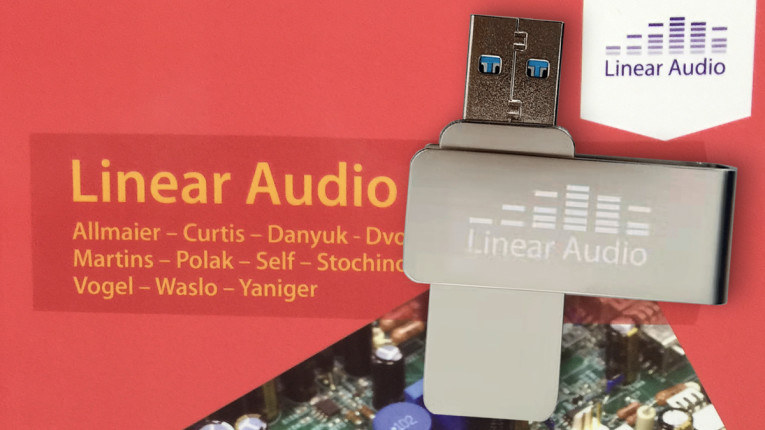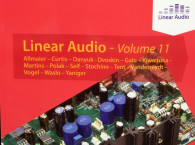
The first issue was a great sign of things to come — over a dozen down-to-earth technical articles on a wide range of audio topics. The final issue of Linear Audio was published in April 2017. Jan noted that after 14 issues and two books, it was time to move on, and that back issues would continue to be available on the Linear Audio website. Those who were fortunate to purchase each issue amassed an invaluable technical reference library.
The entire series has now been released on a USB flash drive that also includes some very worthwhile bonus material. The articles in Linear Audio are of such uniformly excellent quality that singling out “highlights” is difficult. Book reviews were also a regular feature. The “extras” on the flash drive include a five part video series by Jan about “Feedback in Audio Amplifiers,” totaling more than two hours, and eight additional articles, some recent and others of considerable historical interest.
These include Jan’s interview with Malcolm Hawksford (originally published in audioXpress, November 2009), a slide show for a presentation by Jan on amplifier feedback (with contributions by Bob Cordell), John M. Miller’s “Combining Positive and Negative Feedback” (Electronics, March 1950), another article by Miller on the origin of the “Miller Effect” (Scientific Papers of the Bureau of Standards, 1919-1920), H. S. Black’s “Stabilized Feedback Amplifiers” (Bell System Technical Journal, January 1934), and 21 pages of hand-drawn notes related to feedback in audio amplifiers by Jan (uncredited, but Jan told me that he wrote these at least five years ago for a presentation; “En” in the upper right corner of each page indicates the English version).
I recommend copying the contents of the flash drive to a folder on your hard drive. This will make the files and folders easier to access, and provide a safety copy. A file called “start.pdf” loads the main index, with links to the entire contents (the Linear Audio issues are searchable). The PDF files for each issue of Linear Audio and each bonus article, along with the five MP4 video files, can also be loaded individually.
Considering the original selling price of around $30 USD per volume, the cost of the flash drive is very reasonable, especially when you consider the additional extra material. The Linear Audio website is still worth a visit, with several books on audio design still available, including Baxandall and Self on Audio Power (a collection of papers by Peter Baxandall and Douglas Self), and High Fidelity Circuit Design by Norman Crowhurst and George Fletcher Cooper.
There are also corrections to some of the articles in Linear Audio, additional project documentation, and numerous free downloads related to Linear Audio articles (www.linearaudio.net). Anyone with a serious technical interest in audio will welcome the availability of Linear Audio in electronic form.

Review by Bob Cordell
I miss Linear Audio. Many readers are aware of the monumental effort of Jan Didden and his numerous authors in making the Linear Audio “bookzine” an outstanding contribution to the science and art of audio. That collection is now available to everyone on a USB stick, along with a generous dose of extra material.
As an enthusiastic subscriber to Linear Audio from Day One, I am quite familiar with most of the articles in the 14-volume series. It is a true collection of audio expertise. I was honored to contribute a couple of articles, and I experienced how seamlessly Jan made it to publish technical material. I have never seen such a high concentration of experts in one publication. Every serious audio designer should have this Linear Audio USB stick — even those who subscribed to Linear Audio — will enjoy the convenience and extra material included.
Those who are not “serious audio designers” also owe it to themselves to get this stick to learn more about audio design. The material is an outstanding blend of educational and sophisticated audio design. A typical issue includes subject groupings such as circuit design, loudspeakers, test and measurement, and tutorials. The latter are educational for newbies and the experienced alike. Many issues included a guest editorial by persons well-known in the field, including John Atkinson and Gary Galo. Most issues included book reviews, another asset for those who would like to delve more deeply into a subject.
Each of the 14 volumes averages about 200 pages — with no advertising! This makes for almost 3000 pages of pure expert text. A typical volume contains 10 to 12 articles, so the set includes about 140 articles created by good writers who are very experienced and know what they are talking about.
Authors include those who are well-known in the field with professional backgrounds and many gifted audio DIYers. As editor, Jan recruited such audio luminaries as Nelson Pass, Sigfried Linkwitz, Richard Burwen, Bruno Putzeys, Barrie Gilbert, and Malcolm Hawsford, to name but a few. Linear Audio was not just a gift to the readers and the audio community. It was a gift to the authors. It provided a valuable platform for them to present material dear to their hearts in a way that did professional justice to their work.
The extras on the stick include some great archive material on audio and negative feedback and some very enlightening discussions of feedback and error correction. These are precious. The five part video by Jan, titled “Masterclass—Feedback in Audio Amplifiers,” is a treat to watch, and very educational. I watched it from start to finish. As one who has delved into the depths and discussions of negative feedback over the years I can tell you than Jan really nailed it, especially for those less experienced in applying negative feedback. It was a pleasure to watch, and Jan is one of the few who can provide great, intuitive explanations of some of the more difficult and controversial aspects of negative feedback. But he didn’t stop there. He gave an insightful overview of various forms of error correction in power amplifiers. Jan also provided one of the most elegant and balanced explanations of Quad’s current dumping scheme that I have seen.
In a related supplemental piece, he re-published a great interview with Malkolm Hawksford, developer of the Hawksford error correction scheme frequently referred to as HEC. There is something in these extras for everyone, from newbie to expert. If you love audio electronics and related subject matter, you will not be sorry you got this convenient collection of top-notch material.

Review by Dimitri Danyuk
A few weeks ago I received a thumb drive from my friend Jan Didden. This particular USB stick contained a bookzine collection—all 14 volumes of Linear Audio. In case you missed it, Linear Audio was compiled and published by Jan Didden from 2011 to 2017 with contributions from many names in the industry, big and small.
I have all the hardcopies of Linear Audio in my library, but I immediately grabbed my laptop, plugged in the USB drive, and opened the content. It felt like a journey back in time to my college years in the late 1970s, when I would visit the university library every month to ask for the newest issue of Wireless World magazine. I still remember the excitement of turning the crisp pages full of valuable and innovative technical information. I particularly remember the audio sections; audio was flourishing back then, before it was absorbed by the computer industry. Browsing the contents of Linear Audio in its digital format gave me the same excitement.
This new format has none of the limitations of the printed copies -- the graphics and diagrams are clear and easy to zoom in on, I can search for specific information, and I don’t need to lug around 14 volumes everywhere I go. The immense wealth of experience, knowledge, and expertise in the audio field was contained right at my fingertips.
The contents of the volumes are extensive, containing information on loudspeaker design, digital audio, solid-state and hollow-state audio, microphones, phonograph records reproduction, and more. The articles within are accessible to a wide audience — some are targeted toward entry-level DIYers, some require very solid knowledge of electronics, some contain a little too much math for comfort, and others, well, others may have been pulled from the trash bin. Nevertheless, I can’t think of another comparable source of information when it comes to audio technology. The Publisher provides a refreshing balance of articles written by both well-known experts in the field and garage audio enthusiasts, ensuring that anyone who is interested in audio technology will find something useful. This unique collection of audio-related articles closes the gap between audioXpress and the preprints of the Audio Engineering Society conventions papers. It looks as though the Linear Audio was inspired by Wireless World and audioXpress.
Unfortunately, there is a sad but logical interruption in the publishing of Linear Audio. Recent developments in Class-D technology — amplifiers with digital audio input and digital post-filter feedback (e.g., from Axign) and GaN output devices — leave almost no room for the audio enthusiast to improve upon the electronics. Analog audio has entered the state of being a fashion industry. Even so, I commend and appreciate Jan Didden for his herculean effort to encourage authors and manage a publishing house in order to produce all these volumes of Linear Audio; I cannot imagine the vast amount of work it required. I have thoroughly enjoyed turning (and now scrolling!) through its pages, and will always insist that anyone interested or professionally involved in audio technology should own this collection. aX
The Complete Linear Audio Library
$99 USD Available at: www.diyaudiostore.com







